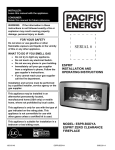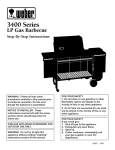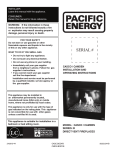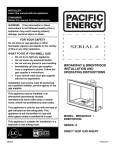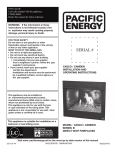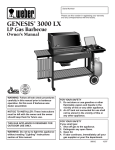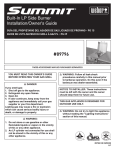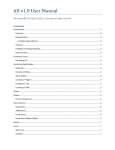Download ESPRIT X6 Operating instructions
Transcript
33333 INSTALER: Leave this manual with the appliance. CONSUMER: Retain this manual for future reference. WARNING: If the information in these instructions is not followed exactly a fire or explosion may result causing property damage, personal injury or death. FOR YOUR SAFETY Do not store or use gasoline or other flammable vapours and liquids in the vicinity of this or any other appliance. WHAT TO DO IF YOU SMELL GAS Do not try to light any appliance. Do not touch any electrical Switch. Do not use any phone in your building. Immediately call your gas supplier from a neighbour’s phone. Follow the gas supplier’s instructions. If you cannot reach your gas supplier call the fire department. LINEAR GAS FIREPLACE INSTALLATION AND OPERATING INSTRUCTIONS Installation and service must be performed by a qualified installer, service agency or the gas supplier. This appliance may be installed in an aftermarket permanently located, manufactured home (USA only) or mobile home, where not prohibited by local codes. This appliance is only for use with the type of gas indicated on the rating plate. This appliance is not convertible for use with other gases unless a certified kit is used. This appliance is suitable for installation in a bedroom or bed sitting room. 090314 ESPR.BODYA MODEL: ESPRIT ESPR.BODYA ZERO CLEARANCE FIREPLACE 5056.201 Important Note for the Commonwealth of Massachusetts: From Massachusetts Rules and Regulations 248 CMR 5.08: (a) For all side wall horizontally vented gas fuelled equipment installed in every dwelling, building or structure used in whole or in part for residential purposes, including those owned or operated by the Commonwealth and where the side wall exhaust vent termination is less than seven (7) feet above finished grade in the area of the venting, including but not limited to decks and porches, the following requirements shall be satisfied. 1. INSTALLATION OF CARBON MONOXIDE DETECTORS. At the time of installation of the side wall horizontal vented gas fuelled equipment, the installing plumber or gas fitter shall observe that a hard wired carbon monoxide detector with an alarm and battery back-up is installed on the floor level where the gas equipment is to be installed, in addition, the installing plumber or gas fitter shall observe that a battery operated or hardwired carbon monoxide detector with an alarm is installed on each additional level of the dwelling, building or structure served by the side wall horizontal vented gas fuelled equipment. It shall be the responsibility of the property owner to secure the services of qualified licensed professionals for the installation of hard-wired carbon monoxide detectors. a. In the event that the side wall horizontally vented gas fuelled equipment is installed in a crawl space or an attic, the hard-wired carbon monoxide detector with alarm and battery back-up may be installed on the next adjacent floor level. b. In the event that the requirements of this subdivision cannot be met at the time of completion of installation, the owner shall have a period of thirty (30) days to comply with the above requirements; provided, however, that during said thirty (30) day period, a battery operated carbon monoxide detector with an alarm shall be installed. 2. APPROVED CARBON MONOXIDE DETECTORS. Each carbon monoxide detector as required in accordance with the above provisions shall comply with NFPA 720 and be ANSI/UL 2034 listed as IAS certified. 3. SIGNAGE. A metal or plastic identification plate shall be permanently mounted to the exterior of the building at a minimum height of eight (8) feet above grade directly in line with the exhaust vent terminal for the horizontally vented gas fuelled heating appliance or equipment. The sign shall read, in print size no less than one-half (1/2) inch in size, GAS VENT DIRECTLY BELOW. KEEP CLEAR OF ALL OBSTRUCTIONS . 4. INSPECTION. The state or local gas inspector of the side wall horizontally vented gas fuelled equipment shall not approve the installation unless, upon inspection, the inspector observes carbon monoxide detectors and signage installed in accordance with the provisions of 248 CMR 5.089(2)(a) 1 through 4. (b) EXEMPTIONS. The following equipment is exempt from 248 CMR 5.089(2)(a) 1 through 4. 1. The equipment listed in Chapter 10 entitled Equipment Not Required To Be Vented in the most current edition of NFPA 54 as adopted by the Board; and 2. Product Approved side wall horizontal vented gas fuelled equipment installed in a room or structure separate from the dwelling, building or structure used in whole or in part for residential purposes. (c) MANUFACTURER REQUIREMENTS --- GAS EQUIPMENT VENTING SYSTEM PROVIDED. When the manufacturer of Product Approved side wall horizontally vented gas equipment provides a venting system design or venting system components with the equipment, the instructions provided by the manufacturer for installation of the equipment and the venting system shall include: 1. Detailed instructions for the installation of the venting system design or the venting system components; and 2. A complete parts list for the venting system design or venting system. (d) MANUFACTURER REQUIREMENTS --- GAS EQUIPMENT VENTING SYSTEM NOT PROVIDED. When the manufacturer of a Product Approved side wall horizontally vented gas fuelled equipment does not provide the parts for venting the fuel gases, but identifies special venting systems , the following requirements shall be satisfied by the manufacturer. 1. The referenced special venting system instructions shall be included with the appliance or equipment installation instructions; and 2. The special venting systems shall be Product Approved by the Board, and the instructions for that system shall include a parts list and detailed installation instructions. (e)) A copy of all installation instructions for all Product Approved side wall horizontally vented gas fuelled equipment, all venting instructions, all parts lists for venting instructions, and/or all venting design instructions shall remain with the appliance or equipment at the completion of the installation. 2 Table of Contents Caution Safety Owners Information First Fire Remote Control Operation Maintenance Lighting Instructions Installer information Fireplace Dimensions Clearances to Combustibles Locating the Fireplace Surround Installation Venting Venting Components Plumbing and Electrical Gas Supply Gas Pressure Check Gas Pressure Testing Procedure Pilot Adjustment Propane Conversion Door Installation / Removal Fan Installation/ Removal Panel Installation/Removal Burner And Tray Installation/Removal Log Set Installation/Removal Glass Burner Kit Installation/Removal Intake Air Damper Installation Sales Codes Wiring Diagram Installation Notes 3 4 5 6 7 15 17 18 20 21 22 23 25 26 27 27 28 28 29 30 30 31 32 33 34 35 36 37 38 Caution FOR YOUR SAFETY - Do not install or operate your Pacific Energy fireplace without first reading and understanding this manual. Any installation or operational deviation from the following instructions voids the Pacific Energy Warranty and may prove hazardous. This appliance and its individual shut off valve must be disconnected from gas supply piping system during any pressure testing of that system at test pressures in excess of 1/2 psi (3.5 kPa). This appliance must be isolated from the gas supply piping system by closing its individual manual shut off valve during any pressure testing of the gas supply piping system at test pressures equal to or less than 1/2 psi (3.5 kPa). Do not use the fireplace if any part has been under water. Immediately call a qualified service technician to inspect the fireplace and to replace any part of the control system and any gas control which has been under water. This fireplace is equipped with a micro mesh safety screen for your protection and must be installed with the unit. Removal of the safety screen will cause the fireplace to become a burn and fire hazard. 4 Safety Due to high temperatures, this gas appliance should be located out of traffic and away from furniture and draperies. Children and adults should be alerted to the hazards of high surface temperatures and should stay away to avoid burns or clothing ignition. Young children should be carefully supervised when they are in the same room as the appliance. Toddlers, young children and others may be susceptible to accidental contact burns. A physical barrier is provided if there are at risk individuals in the house. To restrict access to a fireplace or stove, install an adjustable safety gate to keep toddlers, young children and other at risk individuals out of the room and away from hot surfaces. Clothing or other flammable material should not be placed on or near the appliance. A barrier designed to reduce the risk of burns from the hot viewing glass is provided with the appliance and shall be installed. If the barrier becomes damaged, the barrier shall be replaced with the manufacturer’s barrier for this appliance. Any safety screen, guard, or barrier removed for servicing the appliance, must be replaced prior to operating the appliance. Installation and repair should be done by a qualified service person. The appliance should be inspected before use and at least annually by a professional service person. More frequent cleaning may be required due to excessive lint from carpeting, bedding material, etc. It is imperative that control compartments, burners and circulating air passageways of the appliance be kept clean. This appliance must not be connected to a chimney flue serving a separate solid fuel burning appliance. It is our policy that no responsibility is assumed by the Company or by any of its employees or representatives for any damages caused by an inoperable, inadequate, or unsafe condition which is the result, either directly or indirectly, of any improper operation or installation procedures. 5 OWNER’S INFORMATION Congratulations on your purchase of a Pacific Energy Gas Fireplace. Your fireplace has been professionally installed by: Dealer name: ___________________ Phone Number: _________________ If you discover any problems with your gas fireplace contact your dealer immediately to have the unit repaired. Caution: Do not attempt to repair the fireplace, you may cause injury to yourself or others and risk causing damage to the unit. Before operating your fireplace carefully read this manual and pay close attention to all Safety Warnings. The manual contains important information on the unit’s safe operation and maintenance. First Fire When lit for the first time, the fireplace will emit a slight odour for a couple of hours. This is due to the curing of paints, sealants, gaskets, and lubricants used in the manufacturing process. This condition is temporary. Open doors and windows to ventilate the area. Odour caused by the curing process may cause discomfort to some individuals. It is normal for fireplaces fabricated from steel to give off some expansion and/or contraction noises during the start up or cool down cycle. Similar noises are found with your furnace heat exchanger or cook stove oven. 6 Remote Control Operation ` OWNER’S INFORMATION Important The Proflame Transmitter is an integrated part of the Proflame System, which consists of: • Proflame Transmitter, to be used in conjunction with • Integrated Fireplaces Control (Proflame IFC) The Proflame Transmitter provides for controlling of the following hearth appliance functions: 1. Main Burner On/Off 2. Main Burner flame modulation (6 levels) 3. Choice of standing or intermittent pilot (CPI/IPI) 4. Thermostat and Smart thermostat functions 5. Accent light modulation (6 levels) 6. Split flow valve 7. Comfort Fan speed modulation (6 levels) Transmitter (Remote Control with LCD Display) The Proflame Transmitter uses a streamline design with a simple button layout and informative LCD display (Fig. 1). A Mode Key is provided to index between the features and a Thermostat Key is used to turn on/off or index through Thermostat functions (Fig. 1 & 2). Additionally, a Key Lock feature is provided (Fig. 21). Figure 1: Proflame Transmitter 7 OWNER’S INFORMATION Technical Data Remote Control Supply voltage Ambient temperature ratings Typical operative distance in free air Radio frequency 4.5 V (three AAA LR03 1.5 V batteries) 0 - 50 °C (32 - 122 °F) 12 m 315 MHz ( FCC version ) 433.92 MHz ( CE version ) WARNING THE TRANSMITTER AND RECEIVER ARE RADIO FREQUENCY DEVICES. PLACING THE TRANSMITTER IN OR NEAR METAL MAY SEVERELY REDUCE THE SIGNAL RANGE. METALLIC STRUCTURES OR RADIO INTERFERENCES CAN REDUCE THE OPERATIVE DISTANCE OF THE DEVICE DEPENDING ON TYPE OF FIREPLACE, INSTALLATION AND ENVIROMENT. ATTENTION! - TURN “OFF” THE MAIN GAS SUPPLY OF THE APPLIANCE DURING INSTALLATION OR MAINTENANCE OF THE RECEIVER DEVICE. - TURN “OFF” MAIN GAS SUPPLY TO THE APPLIANCE PRIOR TO REMOVING OR REINSERTING THE BATTERIES. - IN CASE OF REMOTE CONTROL MALFUNCTION TURN OFF THE IFC DEVICE USING THE “ON/OFF” MAIN SWITCH. - FOR INSTALLATION/MAINTENANCE SWITCH OFF THE IFC DEVICE REMOVING MAIN POWER SUPPLY PLUG. - THE DEVICE IS NOT SUITABLE FOR THE USE OF RECHARGABLE BATTERIES AND ITS OPERATIVE DISTANCE IS REDUCED WITH LOW BATTERY LEVEL. 8 OWNER’S INFORMATION Wall mounting The Proflame remote control is supplied with an adapter for wall mounting. Install the controller 1.5 m above floor level, well away from heat sources, kitchens, doors or windows. Metallic structures or radio interferences can reduce the operative distance of the device. Make sure to attach the adapter in a level plane without any distortion. Proceed as follows: • Detach the adapter from the body of the remote control; see Fig. A. • Position the adapter on the wall, mark the points for the fixing holes and drill the wall. • Fix the adapter on the wall using the mounting hardware supplied with the remote control. • Insert the remote control onto the adapter as shown in Fig. B. Figure A: Detach the adapter from the body Figure B: Adapter and remote control OPERATING PROCEDURE Initializing the System for the first time Power the receiver. Activate the procedure of the receiver address programming, see the receiver instruction (*). The Receiver will “beep” three (3) times to indicate that it is ready to synchronize with a Transmitter. Install the 3 AAA type batteries in the Transmitter battery bay, located on the base of the Transmitter. (fig. 3) With the batteries already installed in the Transmitter, push the On button. The Receiver will “beep” four times to indicate the Transmitter’s command is accepted and sets to the particular code of that Transmitter. The system is now initialized. (*) The receiver may be independent or integrated to the IFC hearth appliance control module. The receiver instruction may not be independent when part of the IFC. Figure 3: Battery compartment 9 OWNER’S INFORMATION Temperature indication Display With the system in the “OFF” position, press the Thermostat Key and the Mode Key at the same time. Look at the LCD screen on the transmitter to verify that a C or F is visible to the right of the Room Temperature display. (Fig. 4 & 5) Figure 4: Display in Fahrenheit Turn on the Appliance With the system OFF, press the ON/OFF Key on the Transmitter. The Transmitter display will show some other active Icons on the screen. At the same time the Receiver will activate the appliance. A single “beep” from the Receiver will confirm reception of the command. Figure 5: Display in Celsius Turn off the Appliance With the system ON, press the ON/OFF Key on the Transmitter. The Transmitter LCD display will only show the room temperature (Fig. 6). At the same time the Receiver will turn off the appliance. A single “beep” from the Receiver confirms reception of the command. Figure 6: Remote Control Display Remote Flame Control The Proflame has six (6) flame levels. With the system on, and the flame level at the maximum in the appliance, pressing the down arrow key once will reduce the flame height by one step until the flame is turned off. The Up Arrow Key will increase the flame height each time it is pressed. If the Up Arrow Key is pressed while the system is on but the flame is off, the flame will come on in the high position. (Fig. 7) A single “beep” will confirm reception of the command. Figure 7: 10 OWNER’S INFORMATION ROOM THERMOSTAT (Transmitter Operation) The Remote Control can operate as a room thermostat. The thermostat can be set to a desired temperature to control the comfort level in a room. To activate this function, press the Thermostat key (Fig. 1). The LCD display on the transmitter will change to show that the room thermostat is “ON” and the set temperature is now displayed (Fig.8). To adjust the set point, press the up or down arrow keys until the desired set point temperature is displayed on the LCD screen of the transmitter. Figure 8 Smart Thermostat (Transmitter Operation) The Smart Thermostat function adjusts the flame height in accordance to the difference between the set point and the room temperatures. As the room temperature gets closer to the set point the Smart Function will modulate the flame down. If the room temperature is cool the Smart function will modulate the flame up. To activate this function, press the THERMOSTAT key (Fig. 1) until the word "SMART" appears to the right of the temperature bulb graphic (Fig. 9). To adjust the set point, press the up or down arrow keys until the desired set point temperature is displayed on the LCD screen of the transmitter (Fig. 10). Note. When Smart Thermostat is activated, manual flame height adjustment is disabled Figure 9: Smart Flame Function Figure 10 Fan Speed Control If the appliance is equipped with a hot air circulating fan, the speed of the fan can be controlled by the Proflame system. The fan speed can be adjusted through six (6) speeds. To activate this function use the Mode Key (Fig.1) to index to the fan control icon (Fig. 11). Use the Up/Down Arrow Keys (Fig.1) to turn on, off or adjust the fan speed (Fig. 12). A single “beep” will confirm reception of the command. Figure 11 Figure 12 11 OWNER’S INFORMATION Continuous Pilot/Intermittent Pilot (CPI/IPI) selection With the system in "OFF" position press the Mode Key (Fig. 1) to index to the CPI mode icon (fig. 13 & 14). Pressing the Up Arrow Key will activate the Continous Pilot Ignition mode (CPI). Pressing the Down Arrow Key will return to IPI. A single “beep” will confirm the reception of the command. NOTE: this function is available only with Proflame IFC. NOTE: If the system is equipped with a CPI/IPI toggle switch: • Set the CPI/IPI switch to CPI position(switch closed) to enable remote CPI/IPI operation. • Set the CPI/IPI switch to IPI position (switch open) to disable remote CPI/IPI operation. The system will now work in IPI mode only regardless of the selection on the remote control hand set. Figure 13 Figure 14 Remote dimmer control (Light) The dimmer function controls the Light power outlet by power light control. To activate this function use the Mode Key (Fig. 1) to index to the Light icon (Fig. 15 & 16). The intensity of the output can be adjusted through six (6) levels. Use the Up/Down Arrow Keys (Fig.1) adjust the output level. A single “beep” will confirm reception of the command. Note. This function is available only with the Proflame IFC. Figure 15 Figure 16 12 OWNER’S INFORMATION KEY LOCK This function will lock the keys to avoid unsupervised operation. To activate this function, press the MODE and UP Keys at the same time (Fig. 21). To de-activate this function, press the MODE and UP Keys at the same time. Figure 21 LOW BATTERY POWER DETECTION Transmitter The life span of the remote control batteries depends on various factors: quality of the batteries used, the number of ignitions of the appliance, the number of changes to the room thermostat set point, etc. When the Transmitter batteries are low, a Battery Icon will appear on the LCD display of the Transmitter (Fig. 22) before all battery power is lost. When the batteries are replaced this Icon will disappear. Figure 22 WARNING Fire Hazard. Can cause severe injury or death The Receiver causes ignition of the appliance. The appliance can turn on suddenly. Keep away from the appliance burner when operating the remote system or activating manual bypass of the remote system. 13 OWNER’S INFORMATION DIMENSIONAL DRAWINGS Fig. 23: PROFLAME Transmitter dimensional drawing 14 Maintenance OWNER’S INFORMATION Turn off gas and electrical power supply (if applicable) and allow ample time for unit to cool before servicing appliance. It is recommended that the fireplace and its venting should be inspected at least once a year by a qualified service person. Glass Door: Warning: Do not operate fireplace with glass door removed, cracked or broken. Replacement of the glass door should be done by a licensed or qualified service person. Do not strike or otherwise impact the glass in any way that may cause it to break. If the glass becomes cracked or broken it must be replaced before using the fireplace. Replacement door can be obtained from your nearest Pacific Energy dealer. Do not substitute with any other type. Only the door certified with the appliance shall be used To remove broken glass, remove Door as noted in "Door Removal" section. Annual Inspection: The following procedures must be performed each year by certified personnel. a) Remove glass door and decorative media (such as logs and rocks). Inspect decorative media and burner assemblies for soot buildup. If excessive buildup of soot is present, have a qualified service person inspect and adjust unit for proper combustion. Clean burners with a brush or vacuum cleaner, paying close attention to burner ports. b) Check the pilot system for proper flame size and operation. Pilot light flame must be long enough to overlap the burner ports. Clean pilot hood and spark rod free of soot, dust or any other deposits. . 15 OWNER’S INFORMATION c) Check that the vent pipe and vent terminal are open and free from blockage or debris. The flow of combustion and ventilation air must not be obstructed. If the venting is disassembled for cleaning, it must be properly assembled and re-sealed. d) Check glass panel gasket, replace if necessary. It is important that the glass seal be maintained in good condition. e) Check and replace batteries as needed. Note: The appliance area must be kept clear and free from combustible materials, gasoline and other flammable vapors and liquids. Periodically: a) Viewing glass may be cleaned as necessary with fireplace glass cleaner. b) Exterior finish may be cleaned with mild soap and water. CAUTION: Do not use abrasive cleaners on glass or any other part of the fireplace. Do not clean glass when hot 16 Lighting Instructions 17 OWNER’S INFORMATION INSTALLER INFORMATION Fireplace Dimensions The installation must conform with local codes or, in the absence of local codes, with the National Fuel Gas Code, ANSI Z223.1/NFPA 54, or the National Gas and Propane Installation Code, CSA B149.1 A manufactured home (USA only) or mobile home OEM installation must conform with the Manufactured Home Construction and Safety Standard, Title 24 CFR, Part 3280, or, when such a standard is not applicable, the Standard for Manufactured Home Installations, ANSI/NCSBCS A225.1, or standard for Gas Equipped Recreational Vehicles and Mobile Housing , CSA Z240.4 Fig. 25: Framing Fig. 24: Fireplace Dimensions 18 INSTALLER INFORMATION Fig. 26: Framing At The Corner Fig. 27: Minimum Clearance Corner Framing 19 INSTALLER INFORMATION Clearances to Combustibles LEFT SIDE RIGHT SIDE FRONT Front of the appliance is an open side of the combustion chamber covered with the glass. Facing the front of the appliance side from left is the left side of the appliance and side from right is the right side of the appliance. Figure 28: Minimum Distance From Top Of The Glass To Ceiling Figure 29: Front and Side Definitions Minimum Clearance to Combustible Materials ENCLOSED SIDE WALL ENCLOSED BACK WALL ENCLOSED CEILING ECLOSED FRONT WALL EXPOSED SIDE WALL VENT ENCLOSURE EXTERIOR SOFIT 1.75" NCR* 4" 24" From top of the glass 8" From side of the glass 1" 16" *NCR STANDS FOR NO CLEARANCE REQUIRED; YOU MAY USE COMBUSTIBLE CONSTRUCTION MATERIALS IN DIRECT CONTACT WITH THE APPLIANCE ON THESE SURFACES. When the appliance is installed directly on carpeting, tile or other combustible material other than wood flooring, the appliance shall be installed on a metal or wood panel extending the full width and depth of the appliance. Specified clearances shall be maintained from the top surface of carpeting, tile, etc. 20 Locating the Fireplace INSTALLER INFORMATION In planning the installation for the fireplace, it is necessary to determine where the unit is to be installed, location of vent system and where gas supply piping may be plumbed. Various installations are possible, such as, into an existing wall, a corner, a built in wall or a wall projection. Due to high temperatures, do not locate this fireplace in areas of high traffic or near furniture or draperies. For places where a second side wall is specified, fireplace should be accessible for service Figure 30: Common Installation Location Figure 31: Framing Dimensions 21 INSTALLER INFORMATION Surround Installation Instructions Figure 33: Clean Face Surround Figure 32: Louvered Surround Installation 1. Fasten the surround base to the fireplace using supplied screws and mounting holes located along the inner edge of the base. 2. Install screen with the frame in slots on inner side of the surround base. 3. Install the surround front by positioning it so as to clear the notches and secure by applying downward pressure in order to engage the locking tabs. Figure 34: Surround Dimensions 22 Venting INSTALLER INFORMATION Note: The intake damper positions specified in this chart were set in a controlled testing environment, and serve as a general guideline for installations. Every venting configuration is different, and the damper setting may need slight adjustment from this chart. Note: The vent must not exceed a total length of 35 feet. Any combination of rise and run may be used but must be constrained to the boundaries of this chart. A Maximum of three 90° elbows may be used. Only one (1) 90° elbow or combination of other elbows equalling 90° can be used without reducing horizontal run. For each additional 90° elbow, or an equal combination of elbows, reduce horizontal vent run by 2 feet. Ensure vent pipe is properly supported. 23 INSTALLER INFORMATION This fireplace is certified for use with 4” x 6-5/8”coaxial venting components only. It is permitted to only use certified venting for this appliance. 24 Venting Components NOTE: Mixing venting components from different manufacturers is inadvisable. Figure 35: 4”x6-5/8" Rigid Piping Cross Reference Chart Figure 1: 4”x6-5/8" Rigid Piping Cross Reference Chart Figure 36: 4”x6-5/8" Rigid Pipe Components Cross Reference Chart 25 INSTALLER INFORMATION INSTALLER INFORMATION Plumbing and Electrical Gas connection To make the required electrical and gas connections, start by positioning the gas fireplace. Connect the gas supply line to the 1/2” fitting that located on a shut off valve bracket as seen in Figure 37. A gas shut off valve is located inside the fireplace and may be accessed by removing the inner firebox unit. Please see the gas supply section for requirements of the gas supply. Figure 37: Gas Connection Figure 37A: Electrical Connection Electrical connection Open the access panel as seen in Figure 37A and connect the line wires to the supplied wires inside the junction box using marrettes. A licensed electrician must be used to make this connection. 26 INSTALLER INFORMATION Gas Supply Servicing of the appliance can be performed from the front of the unit by removing the door and the burner tray from the unit. Caution: The gas line should be installed by a qualified service person in accordance with all building codes. This section is intended as a guide for qualified technicians installing this appliance. Consult local and/or national building codes before proceeding. Gas supply line connection is located on the side of the fireplace. Gas connection accepts a ½” NPT fitting. Correct gas line diameter must be used to assure proper operation and pressure. The fireplace input rating is shown in the chart below. A drip leg must be installed in the gas supply line going to the gas control valve to minimize the possibility of any loose scale or dirt within the gas supply line from entering the control valve. Check local codes for additional requirements. Turn on the gas supply and check that all connections are tight and leak free. WARNING: The gas tray including gasket must be reinstalled after conversion/installation or servicing has been completed. Gas Pressure Check Please refer to following page for gas pressure testing procedure. Esprit Gas pressure requirements Gas Orifice NG 2.55mm Input Pressure Natural GasPropane Minimum Maximum 4.5" WC 13.9" WC 11.0" WC 13.9" WC 3.5" WC 1.6" WC 10" WC 6.4" WC LP Manifold Pressure High Low 27 1.52mm Output AFUE 30,000 btu/hr max. 75% 22,000 btu/hr min. 26,000 btu/hr max. 76% 22,000 btu/hr min. INSTALLER INFORMATION Gas Pressure Testing Procedure Note: To test the gas pressure, turn off the gas supply to the appliance before loosening test point screws. Verify gas pressures with the fireplace lit and at the highest setting. 1. Remove window surround and locate the valve as seen in Figure 38. 2. Locate the inlet and outlet test ports on the valve which can be seen in Figure 39. After locating test ports loosen the screws within the ports using a flat-tip screwdriver. 3. Attach pressure gauge to the test ports 4. Turn gas supply back on and test pressures. 5. After testing is finished turn off gas supply, remove the pressure gauges and tighten up the screws in the test points. VENTURI ADJUSTMENT SCREW Pilot Adjustment The pilot flame level can be adjusted by turning the adjustment screw, using a flattip screwdriver, seen on the valve in Figure 39. Figure 24: Valve Location Figure 38: Valve Figure 39: Valve 28 Propane Conversion INSTALLER INFORMATION Before starting the conversion make sure to shut off the gas supply to the unit and allow fireplace to cool to room temperature. To convert the gas fireplace from natural gas to propane the kit is required. This kit comes with new pilot and burner orifices as well as a new pressure modulator for the valve. To switch the pressure modulator, follow the instructions that are provided with the conversion kit. To change the orifices you are required to remove the door, media set, and burner. Please refer to the appropriate sections of this manual and follow instructions on how to correctly remove the components. Figure 40: Burner Orifice and Pilot After removing the burner you will have access to the burner orifice which is located on the bottom of the burner tray, as seen in Figure 40. The orifice can be removed using a ½” socket. Before installing the new orifice, Thread Sealant needs to be applied to the threads of the new orifice to ensure a proper seal when installed. To replace the pilot orifice you will need to remove the pilot hood which is held in place by a spring. First remove the spring, and then remove the hood by pulling it up from the pilot bracket, seen in Figure 41. To remove the existing orifice insert a 5/32” or 4mm Allen wrench into the hexagonal key-way of the orifice and rotate counterclockwise until free. Insert the new orifice using the same Allen wrench and tighten it until a torque of 9 lbf in (1 Nm) is achieved. Replace the pilot hood by aligning the tab on the base of the hood with the slot in the side of the pilot journal, and push the hood down onto the pilot bracket. Replace the spring by pushing it onto its seat. Figure 41: Pilot Before returning the burner into position, the venturi shutter will have to be adjusted to the correct opening. The correct venturi settings are shown in Figure 42. Loosen the screw and slide the shutter. Tighten the screw, and return the burner into position. Figure 42: Venturi Shutter 29 INSTALLER INFORMATION Door Installation/Removal Installation 1. Place the door in the slot at the bottom of the firebox opening. 2. Hold the door against the firebox. Push 3 levers at the top of the door to secure the door. Removal 1. Hold the door. Pull 3 levers to release the door. 2. Lift the door up to release it from the slot on the bottom of the firebox. Figure 43: Door Fan Installation / Removal Fan removal after fireplace installation. 1. Remove door surround and glass frame with the glass as seen in Figure 44. 2. Turn off main gas supply to unit and disconnect 3/8" flex tubing from inner firebox. Also disconnect power cord from inner firebox. 3. Remove rock tray and burner. 4. Remove baffle, rear panel and side panels. 5. Remove burner tray together with valve assembly. 6. Disconnect fan electrical wires and remove fan fasteners. 7. Remove fan out of the firebox assembly. Figure 44: Fan Installation/Removal 30 INSTALLER INFORMATION Fan removal before fireplace installation. 1. Remove fan panel at the rear side of the fireplace as seen in Figure 44. 2. Disconnect fan electrical wires and remove fan fasteners. 3. Remove fan out of the firebox assembly. Panel Installation / Removal Installation/Removal 1. Insert back panel so that it is sitting on ledge at the back of the firebox as shown in Figure 46. 2. Insert first side panel by inserting the front edge of the panel into the lip at the front of the firebox. Then slide the back of the panel until it reaches the firebox side wall. See Figure 47. 3. Repeat steps 2 for the second side panel. 4. To hold panels in place, install the baffle, from the burner kit, by resting the back flange on top of the back panel and use two screws to secure the front of the baffle to the top of the firebox, seen in Figure 48. 5. Do panel removal in reverse order. Figure 45: Panel Set Figure 46: Back Panel Figure 47: Side Panel Figure 48: Baffle Mounts 31 INSTALLER INFORMATION Burner and Tray Installation / Removal Burner Tray Installation / Removal Installation Place the burner tray in the fireplace. Turn off main gas supply to unit and connect 3/8" flex tubing and power cord from inner firebox . Secure tray with screws placed around the perimeter of the tray using a screwdriver, as seen in Figure 49. Figure 49: Burner Tray Removal Remove the screws seen in Figure 49 using a screwdriver. Turn off main gas supply to unit and disconnect 3/8" flex tubing from inner firebox. Also disconnect power cord from inner firebox and remove the burner tray. Burner Installation / Removal Installation Place the burner in firebox so that the venturi is over top of the orifice. To secure the burner, insert the screws as seen in Figure 50 using a screwdriver . Removal Remove the screws as seen in Figure 50 and lift the burner out of the unit. Figure 50: Burner Embers Placement Place embers chunks in rock tray as seen in Figure 51. Do not block air openings and pilot elements with embers. Figure 51: Ember Placement 32 INSTALLER INFORMATION Log Set Installation / Removal Place the Logs #1 and #2 as seen in Fig.53 than place Log #3 over dowel pin on Log #2 as seen in Fig.54. Place Log #6 to the left side seen in Fig 55. Place side Log #5 and #4 as seen in Fig 56. Place Log #7 as seen in Fig.57 Complete Log Set should look like it is shown in Fig 58. Logs should not touch the flame and overlap pilot or air openings in rock tray. Figure 52: Log Set Figure 53: Two Rear Logs Figure 54: Rear Log Set Figure 55: Left Side Log Figure 56: Front Logs Figure 58: Complete Setup Figure 57: Middle Log 33 INSTALLER INFORMATION Glass Burner Kit Installation / Removal Glass Installation To install the glass, evenly spread a thin layer of crushed glass across the entire burner pan as seen in Figure 67. )) To install the optional rock set, simply place desired number of rocks into the fireplace pan as seen in Figure 68 making sure no rocks are in the flame when the unit is operating. Figure 67: Glass Installation Figure 68: Rocks Installation 34 Intake Air Damper Installation INSTALLER INFORMATION The Esprit fireplaces come with the damper that can limit the flow of intake air. This damper is located behind the air baffle at the top of the inner firebox. Sometimes on installations that involve vertical venting configurations over 23 feet in height, the intake air tends to accelerate down the vent causing hectic flame action. This damper can be closed to reduce the speed of the intake air and thus calm the flames to a more natural look. See Page 23 to check if damper required for installation. 35 INSTALLER INFORMATION ESPRIT LINEAR GAS FIREPLACE SALES CODES UNIT ESPRIT LINEAR GAS FIREPLACE ...................................... ESPR.BODYA REPLACEMENT PARTS ESPRIT REPLACEMENT DOOR WITH GLASS ................... ESPRIT REPLACEMENT SCREEN ...................................... PROPANE CONVERSION KIT .............................................. COMPLETE REPLACEMENT GAS TRAY ............................ REPLACEMENT GAS VALVE ............................................... REPLACEMENT CONTROL MODULE ................................. REPLACEMENT PILOT ASSEMBLY .................................... REPLACEMENT REMOTE CONTROL ................................. REPLACEMENT BLOWER ................................................... ESPR.DOORA ESPR.SCRNA GASC.LPKIT ESPR.BRNTRAYA GASC.VALVEA GASC.MODA GASC.PILOTA GASC.CNTRLB GASC.SBLOWA BURNER OPTIONS LOG BURNER SET ............................................................... GLASS BURNER SET ........................................................... GLASS 5LB BLACK ............................................................... GLASS 5LB TWILIGHT ......................................................... GLASS 5LB DESERT ............................................................ GLASS 5LB PACIFIC ............................................................ ESPR.NG01A ESPR.NG03A GASC.5GLBK GASC.5GLTW GASC.5GLDE GASC.5GLPA PANEL SETS PORCELAIN PANEL SET BLACK ......................................... PORCELAIN PANEL SET TITANIUM ................................... PORCELAIN PANEL SET COFFEE BEAN ........................... PORCELAIN PANEL SET COPPER ..................................... PORCELAIN PANEL SET RED ............................................. PORCELAIN PANEL SET IVORY ......................................... ESPR.PNPBKA ESPR.PNPTIA ESPR.PNPCBA ESPR.PNPCUA ESPR.PNPRDA ESPR.PNPIYA SURROUND AND TRIM OPTIONS CONTEMPORARY BACKING PLATE BLACK....................... CONTEMPORARY BACKING PLATE GREY........................ CONTEMPORARY FRONT TRIM PLATE.............................. CONTEMPORARY FRONT TRIM PLATE - BLACK .............. CONTEMPORARY FRONT TRIM PLATE - STAINLESS ...... LOUVERED SURROUND BLACK ......................................... LOUVERED SURROUND GREY........................................... ESPR.CSURRA ESPR.CSURRGYA ESPR.CSTGYA ESPR.CSTBKA ESPR.CSTSSA ESPR.LVSBKA ESPR.LVSGYA DESIGN OPTIONS TRANQUILITY ROCK SET .................................................... METRO ROCK SET - BLACK ................................................ METRO ROCK SET - GREY ................................................. GASC.TRANQA GASC.METROBKA GASC.METROGYA PERFORMANCE OPTIONS OPTIONAL BLOWER KIT ...................................................... LP CONVERSION KIT ........................................................... 36 ESPR.BLOWKITA GASC.LPKIT Wiring Diagram INSTALLER INFORMATION Caution: Label all wires prior to disconnection when servicing controls. Wiring errors can cause improper and dangerous operation. Verify proper operation after servicing. 37 INSTALLER INFORMATION Installation Notes NOTES: __________________________________________________________________________________________________ __________________________________________________________________________________________________ __________________________________________________________________________________________________ __________________________________________________________________________________________________ __________________________________________________________________________________________________ __________________________________________________________________________________________________ __________________________________________________________________________________________________ __________________________________________________________________________________________________ __________________________________________________________________________________________________ __________________________________________________________________________________________________ __________________________________________________________________________________________________ __________________________________________________________________________________________________ __________________________________________________________________________________________________ __________________________________________________________________________________________________ __________________________________________________________________________________________________ __________________________________________________________________________________________________ __________________________________________________________________________________________________ __________________________________________________________________________________________________ __________________________________________________________________________________________________ __________________________________________________________________________________________________ __________________________________________________________________________________________________ __________________________________________________________________________________________________ __________________________________________________________________________________________________ __________________________________________________________________________________________________ __________________________________________________________________________________________________ __________________________________________________________________________________________________ __________________________________________________________________________________________________ __________________________________________________________________________________________________ __________________________________________________________________________________________________ __________________________________________________________________________________________________ __________________________________________________________________________________________________ __________________________________________________________________________________________________ __________________________________________________________________________________________________ __________________________________________________________________________________________________ __________________________________________________________________________________________________ __________________________________________________________________________________________________ 38 INSTALLER INFORMATION 39 Technical support: 1-250-748-1184 Web site: www. pacificenergy.net 2975 Allenby Rd., Duncan, BC V9l 6V8








































